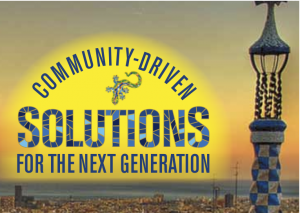Pharmacokinetics and safety of moxifloxacin in children
29 January 2015. Related: Conference reports, Paediatric care, PK and drug interactions, World Conference on Lung Health 45th 2014.
 Polly Clayden, HIV i-Base
Polly Clayden, HIV i-Base
Moxifloxacin concentrations were lower in children than adults according to pharmacokinetic (PK) data presented at the 45th Union World Conference on Lung Health. [1]
The Desmond Tutu centre at Stellenbosch University, Cape Town has a large, ongoing study looking at PK and safety of second line anti-TB drugs in HIV positive and negative children with drug resistant (DR)-TB. We have reported data from this programme presented at previous Union meetings. [2, 3]
Late-generation fluoroquinalones – moxifloxacin and levofloxacin – are potent against multi-drug resistant (MDR)-TB. South African guidelines recommend moxifloxacin for children >20kg and >8 years old and levofloxacin for those <20kg and <8 years old.
Moxifloxacin is currently considered the most potent against MDR-TB. It has 90% bioavailability, food has little effect on absorption: about 50% is metabolised by the liver, about 20% is excreted unchanged in urine and 25% in faeces.
Currently only 400 mg tablets are available. The moxifloxacin WHO-recommended daily dose is 7.5 – 10 mg/kg.
Following a standard 400 mg oral dose in adults, PK values have been described in the literature as follows: AUC0-24 40 – 60 ug*h/mL, Cmax 4 – 6 ug/mL, Tmax 1 -2 hours, and T1/2 of 6–10 hours.
Pharmacodynamic (PD) targets of fluoroquinalones: AUC0-24/MIC, target 100 and Cmax/MIC target 8 – 10.
Steffi Thee presented findings from a nested study in the large MDR-TB drug PK one, conducted to describe the PK of moxifloxacin and to characterise the tolerability and safety of the drug.
HIV positive and negative children 8 – 15 years of age, receiving moxifloxacin as part of routine MDR-TB treatment, were enrolled; those with lab-documented anaemia (Hb <8 g/d/L) were excluded.
Moxifloxacin was dosed at 10 mg/kg and taken on an empty stomach with all anti-TB medications. Intensive PK sampling (0, 1, 2, 4, 8 and 6 or 11 hours) of moxifloxacin at steady state (2 – 8 weeks) was performed. Liquid chromatograpy-tandem mass spectrometry was used in the evaluation; all assays were conducted at the University of Cape Town Clinical Pharmacology Department.
Routine and laboratory safety assessments were conducted monthly for the first 6 months of treatment, then every 2 months until completion. Liver function tests, creatinine and complete blood cell counts were performed on children receiving antiretrovirals or linezolid; thyroid function was measured in children receiving ethionamide or PAS. Cardiotoxicity was measured. Adverse events were graded using DAIDS criteria.
Dr Thee presented data from 23 children. At baseline they were a median age of 11.1 years (IQR 9.2 – 12.0) and weight of 28.9kg (range 21 – 66 kg). Nine (39.1%) were boys; 13 (56.5%) and 10 (43.5%) were defined as black and coloured ethnicity respectively; 11 (47.8%) had experienced a previous TB episode or treatment; 12 (52.2%) had a known TB source case; 19 (82.6%) had a bacteriologically confirmed TB diagnosis and 4 (17.4%) a probable TB diagnosis; 14 (60.9%) had pulmonary TB, 3 (13.0%) extra-pulmonary TB and 6 (26.1%) had both; 6 (26.1%) children were HIV positive; and 3 (13.0%) had weight-for-age z-score <-2.0%.
Dr Thee reported that the evaluation found the moxifloxacin Cmax in children nearly approximated that with a 400 mg adult dose but the AUC was substantially lower. Table 1 shows moxifloxacin PK parameters by HIV status, nutritional status and administration method.
| PK Parameter | Cmax (ug/mL) | Tmax (h) | AUC0-8 (ug*h/mL) | ||||
|---|---|---|---|---|---|---|---|
| n | Median (IQR) | p-value | Median (range) | p-value | Median (IQR) | p-value | |
| HIV positiveHIV negative | 617 | 2.83 (2.36 – 2.94)3.21 (2.95 – 3.82) | 0.08 | 2.0 (1.0 – 4.0)4.0 (1.0 – 8.0) | 0.33 | 13.19 (11.8 – 15.9)19.98 (16.71- 25.21) | 0.003 |
| WAZ > –2.0WAZ <–2.0 (UWA) | 203 | 3.08 (2.87 – 3.71)2.78 (1.99 – 4.06) | 0.41 | 2.0 (1.0 – 8.0)2.0 (1.0 – 8.0) | 0.59 | 18.76 (16.43 – 23.6)14.47 (9.95 – 15.9) | 0.045 |
| Whole drugCrushed drug | 203 | 2.96 (2.82 – 3.71)3.21 (3.08 – 4.06) | 0.29 | 3.0 (1.0 – 8.0)1.0 (1.0 – 2.0) | 0.047 | 17.36 (14.93 – 23.6)17.24 (14.47– 19.53) | 0.72 |
Using MIC90 0.5 mg/L, the PD targets were not achieved: mean AUC0-24/MIC(IQR), 56.1 (SD 25.1) vs target 100 and mean Cmax/MIC(IQR) 6.5 (SD 1.5) vs target 8 – 10.
ECG was performed in 12 children. The mean QT interval was 362 ms (SD 40 ms) and mean QTc 403ms (SD 30 ms). None had QTc interval >450 ms.
One child had a grade 3 ALT elevation possible related to moxifloxican, all other adverse events were mild and not persistent grade 1 or 2.
Dr Thee suggested that future directions should include: dose optimisation of moxifloxacin in more child-friendly regimens and formulations, investigation into formulation effects on bioavailability, and evaluation of larger cohorts for safety assessment and further investigation into clinical covariates, including HIV coinfection.
Comment
The large five year study of second-line treatment has an enrollment target of about 300 children. Age matched HIV positive children who are not on TB treatment are enrolled as controls.
The drugs under evaluation are: ethionamide, terizidone, ofloxacin, levofloxacin, moxifloxacin, amikacin, high dose isoniazid (INH), PAS, linezolid and capreomycin. The group will be looking at delamanid and bedaquiline and novel TB drugs as they become available for children.
References:
- Clayden P. Paediatric TB: glimpses of PK data and a potential new approach to drug development. HTB, January/February 2013.
https://i-base.info/htb/20861 - Clayden P. Preventing and treating TB in children – more baby steps. HTB, November/December 2013.
https://i-base.info/htb/24037 - Thee S. The pharmacokinetics and safety of moxiflixacin in HIV-infected and HIV uninfected children with MDR-tuberculosis. 45th Union World Conference on Lung Health. Barcelona, Spain. 28 October – 1 November, 2014. Symposium abstracts, Saturday, 1 November S49.
http://slideonline.eu/recordings/2014/14union

